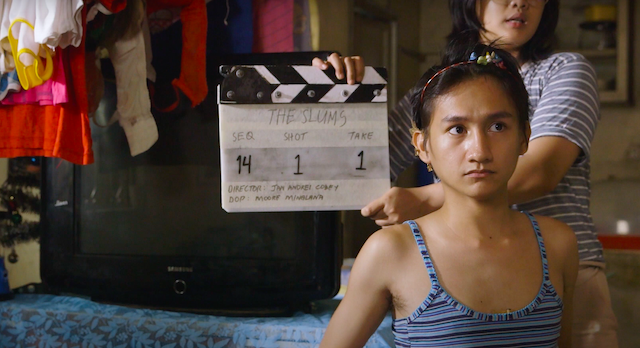
For Cinemalaya’s 16th year, the festival has gone online, much like many events have been forced to do since the onset of the pandemic. While I strongly believe that going to the cinema to watch a film is a heavenly experience, Cinemalaya’s decision to push through with online streaming is a decision that brings so many quality films to the small screens of the Filipinos who are more than willing to consume them in the safety of their own homes.
This year’s online run also boasts an impressive lineup of short films and documentaries that can become starting points for conversations about the new normal that we are trying to build. The line-up for the main competition is definitely a must-watch, but if you’re still on the fence about an at-home screening, here are some reasons that will definitely convince you to start watching.
“Fatigued” By James Robin Mayo
This film stands out from the others in the main competition line-up as it’s an interactive one, similar to “Black Mirror’s” “Bandersnatch.” The film is formatted like a game, where you control an overworked employee who’s trying to wake up from a nightmare in order for him to go to work.
Watching this with other people is best as the opening of the film says that the reactions of those watching with you will enhance the viewing experience. If you’re not into the idea of creepy visuals and social interaction, then stay for the commentary of the overworked employee who’s merely a cog in the great machine of capitalism. Yay, fun!
“Ang Gasgas Na Plaka Ni Lolo Bert” By Janina Gacosta and Cheska Marfori
We rarely get love stories between older people, much less gay ones so this one is definitely a watch for the representation. The film focuses on the titular character: cold, snobbish and lonely Lolo Bert who is coaxed by a widowed vinyl shop owner into a friendship and maybe even something more.
The film is quiet, representative of the isolation that Lolo Bert lives through being an old closeted man living with HIV. The moments of quiet in the film allow the audience to fill in the blanks with their own conclusion on what could happen between the two main characters. Ultimately it’s a story of nostalgia and companionship—a perfect quarantine watch for the socially distanced.
“Ang Pagpakalma Sa Unos” (To Calm The Pig Inside) By Joanna Vasquez Arong
Look, it’s difficult to face grief and misfortune. But we gotta do it. Special jury prize winner “Ang Pagpapakalma Sa Unos” does just that through photos, drawings, news footage and on-the-ground videos of the disaster that is Typhoon Haiyan.
The most heartbreaking thing about this movie is that there is no way to write out the conflict, nature is unforgiving to a defenseless community. Natural calamity isn’t the only evil here. The film shows how willingly people can take advantage of tragedy-stricken individuals for their own good—something that can be hauntingly familiar right now. In the end, the story is hopeless but it needs to be told. Hopefully, we learn from it.
“Living Things” By Martika Ramirez Escobar
Oh, to be a cardboard standee riding a nighttime caterpillar ride. The premise of “Living Things” is how one can stay with a partner that never changes—literally because they’ve turned into a cardboard standee.
While it mostly tackled a long relationship that might be due for a reckoning, it can also resonate with those who have found themselves in a stagnant state of life. Never improving or advancing from what they are now. But there are ways to counter that, at least this best-directed film says so. And who knows? Maybe being as constant as a cardboard standee could help you in the long run, too.
“Pabasa Kan Pasyon” By Hubert Tibi
As a Catholic school alum, I’m very wary about anything related to religion. I know there are a lot of good sides to it, especially for people who are struggling to anchor in the existential dread. But “Pabasa Kan Pasyon” flips the script on somber and sincere devotees. The central figures actively use religion and rely on it solely to earn a living.
This film’s humorous take on using religion to literally gain a footing in life deserves its best screenplay award. From a radio DJ acting out the crucifixion to people lining up for a photo with an actor playing Herod who just slapped actor Jesus in the face, these scenes will make you laugh but wonder, in the back of your mind, “Am I laughing because I too use the Lord’s name in vain?”
“Excuse Me Miss, Miss, Miss” By Sonny Calvento
I haven’t gone to malls since quarantine started but I don’t really miss them. “Excuse Me Miss, Miss, Miss,” solidified that feeling. This film, which takes place in a trendy department store, tackles the struggle of contractual employees and how draining and demeaning that state of employment can be.
When feisty sales lady Vangie defends her actions after the store manager calls her lazy, she takes it upon herself to find out how the store manager maintains her work-life-leisure-sex balance. Her journey to end her contractual status leads her to confront the very system that places the onus of production and profit into the hand of the underpaid and exploited manual laborer. The only question is, will she submit to it?
“Quing Lalam Ning Aldo” (Under The Sun) By Reeden Fajard
If you miss your family, home-cooked meals and the feeling of home, this is the movie to watch. “Quing Lalam Ning Aldo” is the story of how a trans Sampaguita farmer works to renovate their outdoor kitchen in time for her OFW son’s homecoming.
Lauded as Cinemalaya’s audience choice awardee, this film speaks on all the missed opportunities that passed us by in life. But it doesn’t stay too long on the sad parts—there will always be light at the end of the tunnel and you can be guided to it by those who love and support you the most.
“The Slums” By Jan Andrei Cobey
This mockumentary was the first of the main competition shorts that caught my eye. Aside from the subject matter, a documentary film team follows the misadventures of a low-income family who loses their TV. I was drawn to this film because of its humor and satirical take on poverty porn.
Romanticizing marginalized communities is definitely a problem, especially when it comes to news and media. Pictures of resilience amid poverty fail to recognize the system that enabled poverty in the first place, and this film shows exactly how a family calls that out and takes the problem into their own hands. You come to this film for the comedic performances but stay for its profound message of how tokenism will always do harm to the tokenized.
“Tokwifi” By Carla Pulido Ocampo
This year’s best film is a story of a young Igorot man who crosses paths with a 1950s mestiza actress. The catch? The actress is trapped in a TV set and encounters the young man only after having fallen from the sky.
Best film is a big mantle which “Tokwifi” holds well. Romance and comedy aside, the film shows the harmful and hurtful stereotypes we often hold against our fellow Filipinos and the steps we can take to overcome that. It also does a great job of showing the struggle of preserving Filipino identity even under neo-colonization and modernization.
“Utwas” (Arise) By Richard Salvadico and Arlie Sweet Sumagaysay
My favorite of this year’s lineup is the beautifully shot “Utwas.” The film tells the story of a father training his son to be a diver through breathing exercises and swimming drills. The ocean is a scary place, but this film shows that the scariest part of the ocean is the people trying to profit off of it.
While the film starts off as a light-hearted picture of a father trying to do right by his son, it quickly turns into an anxiety-inducing escape room film. You’ll walk away from this short promising yourself to always heed your parents’ advice.
Header photo screengrabbed from “The Slums” official trailer
Follow Preen on Facebook, Instagram, Twitter, YouTube, and Viber
Related stories:
A love story between an Igorot man and an actress trapped in a TV is Cinemalaya’s best film
A cheat sheet to the 15 Filipino films coming to Netflix
Rainy day movies to pair with those hard-to-comprehend feelings
Stream-only movies can bag awards at the Oscars—but there’s a catch

